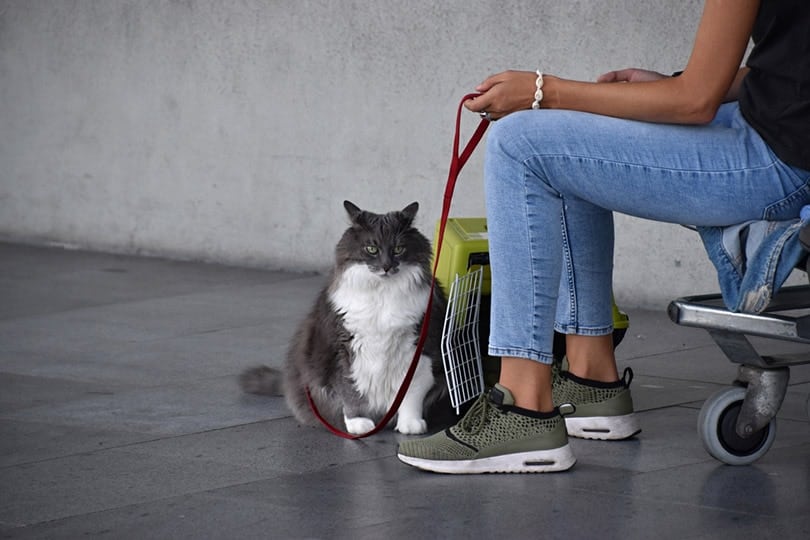There are few experiences more tragic than losing a pet. No cat owner wants to endure the heartache of losing their beloved pet, but sadly, many do. Whether you’ve experienced this grief or not, you can prevent future losses by recognizing Lost Pet Prevention Month.
Lost Pet Prevention Month is held through the month of July. It aims to raise awareness of missing pets and prevent the loss of more companion animals. This campaign is an important part of ensuring that our beloved cats do not become part of a tragic statistic.


Why was National Lost Pet Prevention Month established?
If you had to guess what the busiest day of the year is for animal shelters, what would you choose? It may seem strange to think that one day a year sees a consistent, massive increase in surrendered or stray animals, but it’s the truth.
In the United States, July 5th is the busiest day of the year for animal shelters. This is mainly because the noisy Fourth of July celebration can startle pets, causing them to flee at a moment’s notice.
In addition, families take more trips during the summer. Pets being taken along for the trip can become stressed by their new surroundings, causing them to run away. The frequency of pet disappearances this month has caught the attention of PetHub, an organization dedicated to creating tools that track lost pets.
In 2014, they launched the first ever Lost Pet Prevention Month to spread awareness and prevent more pets from getting lost. Lost Pet Prevention Month helps inform and provide cat owners with resources to keep their pets safe.

The Sad Reality of Missing Cats
Each year, approximately 6.3 million animals are delivered to animal shelters across the country. Out of this total, 3.2 million of them are cats. Most cats are lost, surrendered, and rescued. Due to the massive flood of incoming cats, only 2.1 million are adopted annually. Other alarming statistics include:
- Of the 810,000 shelter animals that have been returned to their owners, only 100,000 are cats.
- 530,000 cats are euthanized each year
- Twice as many animals are delivered to shelters as stray or lost pets compared to the number surrendered by their owners.
- Cats make up more than half of euthanized animals in shelters each year.
The statistics are concerning to any animal lover, but especially to cat owners. To prevent your beloved pet from becoming a tragic statistic, you can take action to prevent the loss of your cat.

How to Stop Your Cat from Getting Lost
There are many ways to keep your cat safe. By checking the following steps, you can rest easier at night, knowing that your cat is unlikely to go missing.
1. Keep Your Cat Inside
There are many benefits to making your cat an indoor-only cat. First, the risk of physical hazards decreases significantly because they are less likely to encounter wild animals, territorial cats and dogs, unkind people, or cars. In addition, indoor cats are more likely to have infectious diseases.
2. Put Collars and ID Tags on Your Cat
Even if your cat is only indoors, it’s best to have some type of identification with your cat, just in case. Cats can be sneaky escape artists when they want to be, so don’t rule out the possibility of them sneaking through the door. Cats with collars and ID tags can easily be rehomed if found by a stranger.
Make sure your cat’s ID tag has their name, your name, your address, and your phone number. This ensures that anyone who finds your cat can contact you and bring them home.

3. Microchip Your Cat
Pet owners should also have their cats microchipped. The microchips contain codes that can be read at vet offices or shelters, telling them who the cat is. Be sure to update your cat’s microchip if you move!
4. Keep Your Cat in a Chaotic Environment
Cats can get tired easily, especially when their home is filled with chaos. If you have visitors in your home, your cat may feel threatened and run out the door. To avoid that, plan ahead.
Keep your cat in a quiet and safe room where visitors will not enter. Depending on the length of the visit, provide your cat with toys, food, water, and a litter box to ensure all their needs are met. This will reduce their stress and encourage them to stay right where they are.
5. Make Sure Your Home is Secure
If there is a way for your cat to escape your home, they will find it. Make sure all windows and doors are securely fastened. Your cat should not be able to enter.
If you do let your cat out, make sure they are kept in a fenced area with no means of escape. This means checking your fences or other barriers to make sure there are no weaknesses.
6. Use a Carrier or Strap When Leaving the House
During vet appointments or other events that cause you to leave the house with your cat, be prepared. Use a carrier or leash to transport your cat to and from the house.

7. Train Your Cat to Come When Called
Cats may be independent and aloof, but that doesn’t mean they can’t be trained. By training your cat to come when called, you can maintain better control if they start to wander off.
8. Have a Plan for Emergencies
Natural disasters can happen at a moment’s notice, so having a plan can keep you and your cat safe. Having animal first aid kits, cat travel supplies, and microchipping your cat are great ways to keep them safe in an emergency.


Final Thoughts
No pet owner wants to experience the grief of losing a beloved cat. That’s why Lost Pet Prevention Month exists; it gives pet owners the resources they need to keep their companions safe. Come July, consider participating in Lost Pet Prevention Month by posting on social media or volunteering at your local animal shelter.
Featured Image Credit: StockMediaSeller, Shutterstock


